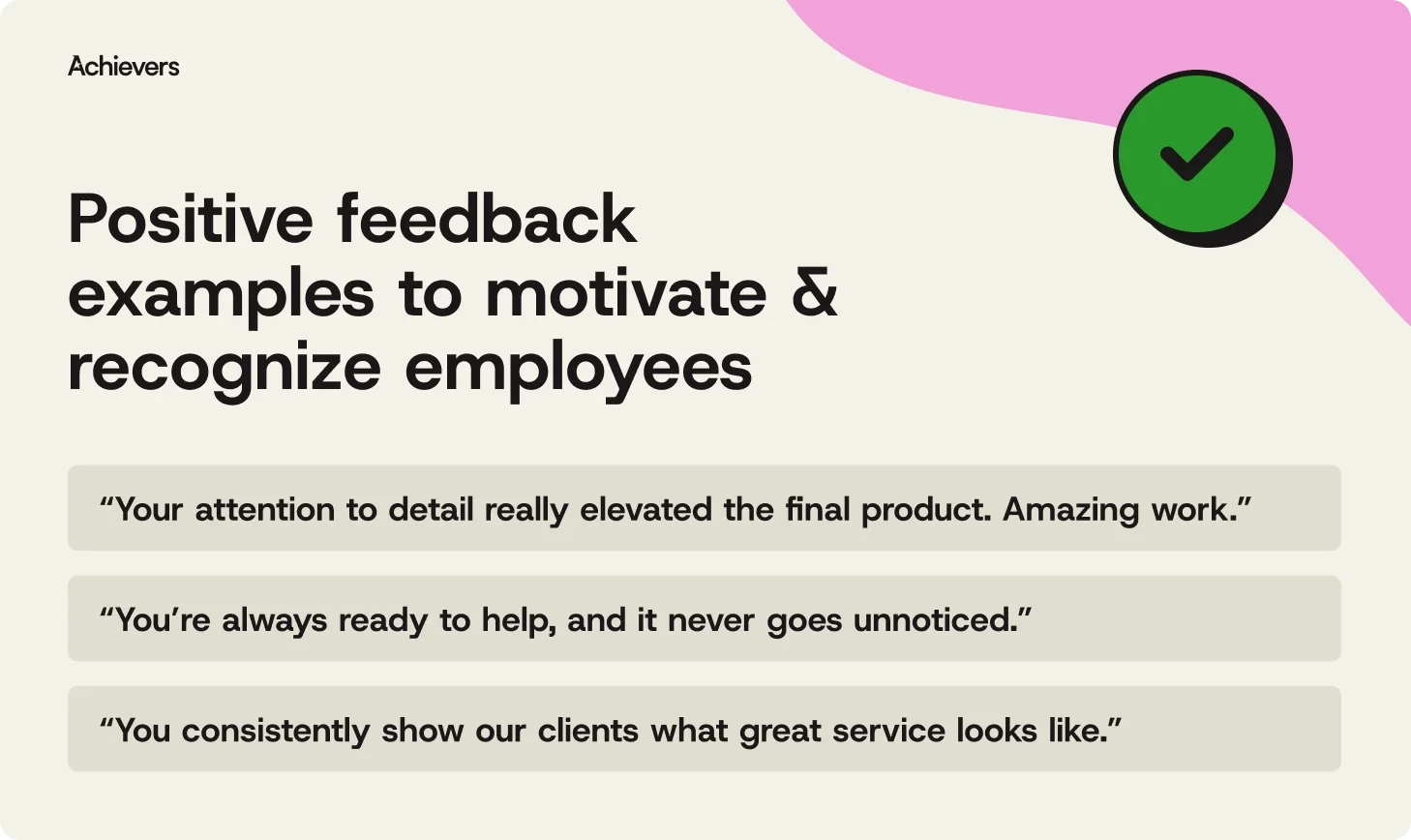Table of contents
Create a culture that means business™
Schedule a demo with an Achievers solution expert today.
Giving feedback should be simple. But when you’re trying to sound genuine (not generic), meaningful (not mushy), and actually human — it gets tricky.
That’s where positive workplace examples come in. A few thoughtful words can build trust, spark motivation, and reinforce the behaviors that drive your culture forward. And the impact? Real. Gallup found that 80% of employees who received meaningful feedback in the past week were fully engaged. Weekly. Not yearly. Not “when someone remembers.”
The good news: you don’t have to come up with the perfect phrase on the spot. Below are 40 ready-to-go examples of positive feedback you can use to recognize your people in the moments that matter — no clichés, no overthinking.
40 positive workplace examples to motivate and recognize employees
Recognition doesn’t need to be formal, fancy, or saved for review season. The best feedback happens in the moment — when it’s personal, honest, and tied to the impact someone’s making.
Whether you’re a manager, peer, or someone who just wants to give credit where it’s due, these 40 positive workplace examples make it easy to show your team they’re seen, appreciated, and doing work that matters.
Positive feedback examples for performance
People notice when their hard work gets overlooked. When you recognize standout performance, you’re not just saying “nice job” — you’re reinforcing what excellence looks like. Call it out early and often.
Examples:
- “Your management of this project was outstanding. We’re ahead of schedule because of your leadership.”
- “You did such a great job in yesterday’s presentation — the client was thrilled.”
- “Your attention to detail really elevated the final product. Amazing work.”
- “I appreciate how consistently you hit deadlines, even under pressure.”
- “The new website looks incredible. Your hard work paid off.”
- “Your productivity is off the charts, and your methods have helped the entire team.”
- “Thanks for staying late to finish up that post-meeting report — we noticed.”
- “Your recent work shows real improvement. Keep it up.”

Recognition for innovation and initiative
Innovation isn’t always about lightbulb moments. Sometimes, it’s spotting a roadblock before it hits or suggesting a smarter way to get things done. When employees take initiative, reward it with encouragement that keeps those ideas coming.
Examples:
- “You identified a potential issue and solved it before it even became a problem. That’s real ownership.”
- “Your idea to streamline the process shaved hours off the timeline — brilliant.”
- “The way you approached this challenge was creative, thoughtful, and effective.”
- “You’re always thinking one step ahead. It’s inspiring to the whole team.”
Feedback that reinforces teamwork and collaboration
You can’t build a strong organizational culture without strong teams. And strong teams don’t happen by accident. When someone shows up for their coworkers — especially behind the scenes — take a moment to say, “I saw that, and it mattered.”
Examples:
- “Thanks for being someone I can always rely on. Your support makes a huge difference.”
- “Your collaboration on that presentation helped bring it to life.”
- “You make every team feel more cohesive just by being in it.”
- “You’re always ready to help, and it never goes unnoticed.”
- “Your ability to stay calm and supportive under pressure is something I really admire.”
Praise tied to recognition and values
Your company’s core values shouldn’t be theoretical. Recognition brings them to life. By tying feedback to your values, you help employees connect the dots between what they do and what your company stands for.
Examples:
- “Congrats on being the most recognized employee this quarter — you clearly make a difference.”
- “You lead by example when it comes to recognizing others. Keep it coming!”
- “The way you brought our sustainability value to life in your latest project? Incredible.”
- “Your social recognition posts are so thoughtful — they’ve become a highlight in our feed.”
- “It’s clear that company values aren’t just words to you — you live them every day.”
Celebrating customer-centric work
There’s a direct line between a happy customer and the employee who made it happen. If someone’s making your brand look good in front of clients, let them know you noticed. Your customers aren’t the only ones who will benefit.
Examples:
- “I’ve never seen a customer review like that. You clearly made a real impact.”
- “Thanks for your patience and empathy in that support call — it reflects everything we aim for.”
- “You consistently show our clients what great service looks like.”
Encouraging professional growth
Growth doesn’t always come with a drumroll. But when someone’s pushing themselves, building new skills, or learning through feedback — that deserves recognition. It’s how you create a culture of continuous improvement (without sounding like a poster).
Examples:
- “Your presentation was a masterclass. It’s clear you’ve been putting your learning to work.”
- “I’m impressed by your dedication to continuous improvement — and it shows.”
- “You’ve shown incredible progress in your communication skills lately.”
- “Your insights lately have really pushed the team forward. I’m learning from you.”
Acknowledging leadership and mentorship
Great leaders don’t need a title — they build trust, coach others, and lead by example. Whether it’s a manager or a teammate stepping into a mentoring role, call out the behavior you want more of.
Examples:
- “You’ve been an incredible mentor from day one. You lead with empathy and clarity.”
- “Thanks for helping me transition into this role — your guidance meant everything.”
- “You really exemplify what good leadership looks like: transparent, fair, and motivating.”
Recognizing wellness and culture-building
Culture isn’t all hands and mission statements — it’s how people show up every day. Recognize the folks who protect their boundaries, bring good energy, and make your workplace a little healthier and more human.
Examples:
- “You walk the walk when it comes to wellness — thanks for normalizing taking time off.”
- “You’ve boosted the team’s morale more than you probably realize. Thank you.”
- “Thanks for creating a culture of positivity — it makes work feel like a team sport.”
- “Your thoughtful approach to today’s meeting set a positive tone for the entire team — thank you for creating such a supportive space.”
Welcoming and encouraging new hires
A new role is exciting… and overwhelming. A little recognition early on helps new hires feel confident, connected, and ready to contribute. It also sets the tone: around here, great work gets noticed.
Examples:
- “Welcome to the team — your fresh ideas and energy are already making an impact.”
- “It’s only been a few weeks, but you’ve jumped in like a pro. We’re lucky to have you.”
- “You’re bringing such a great attitude to the role — can’t wait to keep working together.”
- “You asked great questions in that team meeting — shows you’re already thinking ahead and engaged.”
How to provide positive feedback at work
Saying “good job” is nice. Saying why it was a good job — and doing it at the right time, in the right way — is what makes feedback effective.
Here’s how to deliver positive feedback that sticks the landing:
Be specific and timely
The best feedback doesn’t happen weeks after the fact. Call out the moment when it happens — and tell them exactly what made the difference. It shows you’re paying attention and helps employees repeat the behavior.
“The way you jumped in to clarify the client’s concerns mid-meeting — that was a turning point. You handled it with clarity and calm, and it really landed.”
Choose the right communication channel
A Slack message, a shoutout in a team meeting, a handwritten note — all can be powerful in the right context. The key? Match the moment to the feedback tool, and consider what makes the recipient feel most seen.
“Hi Sarah — just wanted to say, your peer reviews this round were some of the most thoughtful I’ve seen. You clearly put care into every one.”
Pair feedback with personalized rewards
Sometimes words are enough. Other times? A little extra goes a long way. With a points-based reward system, you can turn recognition into something employees actually want and let them choose how they celebrate. It’s personal, it’s flexible, and it makes your feedback feel that much more meaningful.
“Congratulations on your promotion! We’ve added reward points to your account so you can choose something meaningful to celebrate this milestone — you’ve earned it.”
Encourage peer-to-peer recognition
Recognition shouldn’t be top-down only. When teammates lift each other up, it builds trust, connection, and stronger collaboration. Make it easy, and expected, for everyone to give (and get) appreciation.
“Thanks for always being there to bounce ideas off. You’ve made onboarding feel way less overwhelming — I really appreciate it.”
Tie feedback to company values
Values don’t drive behavior unless they’re visible. When you link feedback to a core value — innovation, inclusion, ownership — it shows employees how their everyday actions shape the culture you’re trying to build.
“You took our sustainability goal and made it real — from idea to execution. It’s exactly the kind of value-led thinking we need more of.”
How positive feedback connects to employee voice
Feedback isn’t a one-way street — unless you like talking to yourself. The most impactful cultures don’t just recognize great work; they ask employees what’s working (and what’s not) and actually do something with the answers.
That’s where Achievers’ Voice of Employee solution comes in. It’s designed to help organizations listen with intention, using real-time surveys, polls, and quizzes to gather the insights that spark change. Want to know how employees feel after a big launch? Curious what’s driving (or blocking) engagement? You can ask — and act — in the same platform where recognition already lives.
By combining feedback and recognition in one system, leaders can:
- Reinforce the behaviors that are already working
- Identify blind spots before they become culture issues
- Understand how feedback that’s meant for managers shapes leadership and culture
- Align praise with what employees actually value
When you listen regularly and with intention, feedback becomes part of how people feel heard, valued, and understood. That’s what turns insight into action, and action into real culture change.
Make positive feedback a habit, not a one-off
Meaningful feedback doesn’t need to be complicated. It just needs to happen — often, authentically, and in the moments that matter.
Achievers makes it easy to recognize wins, reward effort, and listen continuously, our platform helps you build a culture where feedback isn’t just a formality — it’s a habit.
From peer-to-peer shoutouts to pulse surveys and real-time insights, Achievers brings recognition and employee voice into one powerful, easy-to-use platform. So you’re not just celebrating the good — you’re learning from it, scaling it, and building something better because of it.



